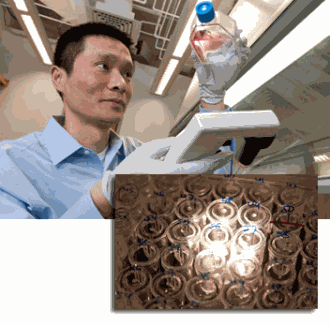With a major assist from the U.S. Department of Energy’s Advanced Photon Source at Argonne, scientists have observed, for the first time, an intermediate stage in the chemical process that repairs DNA methylation damage and regulates many important biological functions that impact health conditions such as obesity, cancer, and diabetes.
The observations focused on the bacterial DNA repair protein AlkB, but the results also apply to several proteins in the same family that play key regulatory roles in humans. Armed with these results, researchers may one day develop methods for blocking the protein’s efforts to perform the biologically important demethylation function in human cells, said Chuan He, Professor in Chemistry at the University of Chicago. The findings were published in the journal Nature on Nov. 11, 2010.
The research reveals new details about how proteins chemically alter biological molecules and their functioning via a process called oxidative demethylation. Methylation is a chemical process that helps control how DNA and proteins carry out their functions in the body. In the case of DNA, methylation and demethylation affect how the genetic code gets made into proteins. In recent years scientists had assumed that AlkB and related proteins initiate an oxidizing reaction to remove a hydrocarbon group (the methyls) from the group’s host molecule.
“This family of proteins is the most exciting protein family now in biology,” said He, who led the group of researchers from the University of Chicago, the University of Wisconsin-Madison, and the Chinese Academy of Sciences. “These proteins directly impact obesity, cancer, and diabetes, and they do not go through the traditional pathways of DNA or protein modification. Most likely they go through RNA modification and demodification. It’s a new area of biological research.
“Biological methylation is one of the most important processes in nature to regulate all kinds of things,” He said, “including how cells differentiate into their final state and how genetic information is transmitted to proteins.”
The University of Chicago researchers recently invented a chemical technique to trap the AlkB protein when it reacts with its host molecule — a previously unobserved, ephemeral process. The technique tethers the protein to the host molecule. “It’s stuck there. It can react and stop at the intermediate stage,” said He.
Two of the enzymatic intermediates that He’s team trapped and observed were predicted and expected based on the chemical principles involved, but these fleeting species were directly observed for the first time. For a third intermediate, however, “we observed something bizarre,” He said.
Researchers at UW-Madison then carried out computational calculations on the electronic and structural properties of the intermediates that He observed in his experiments. The calculations showed that the bizarrely behaving intermediate was “zwitterionic,” meaning that it carried an overall neutral charge, but displayed positive or negative charges when interacting with different atoms.
“We were able to show that the intermediate captured by Chuan’s beautiful experiment is zwitterionic in nature, which offers new clues regarding the chemical steps of the biological demethylation process,” said Qiang Cui, professor of chemistry at UW-Madison.
The team documented the role of oxidation in demethylation utilizing four x-ray beamlines at the APS: General Medicine and Cancer Institutes Collaborative Access Team beamline 23-ID-B, Structual Biology Center Collaborative Access Team 19-BM, BioCARS 14-BM, and Life Sciences Collaborative Access Team 21-ID-D. The high-brightness x-rays from the APS permitted the research team to determine the crystal structures that show the three-dimensional atomic framework of the intermediate stage in the demethylation process.
Members of He’s research team visited the APS two or three times a month for a full day of experimentation. “We literally collected close to a hundred data sets there,” He said. The researchers take multiple data sets at different intervals to confirm the accuracy of their results.
See: Chengqi Yi1, Guifang Jia1, Guanhua Hou2, Qing Dai1, Wen Zhang1, Guanqun Zheng1, Xing Jian1, Cai-Guang Yang1,3, Qiang Cui2, and Chuan He1*, “Iron-catalysed oxidation intermediates captured in a DNA repair dioxygenase,” Nature 468, 330 (11 November 2010). DOI:10.1038/nature09497
Author affiliations: 1The University of Chicago, 2University of Wisconsin-Madison, 3Chinese Academy of Sciences
Correspondence: *chuanhe@uchicago.edu
This study was supported by the National Institutes of Health (GM071440 to C.H.; GM084028 to Q.C.). Computational resources from the National Center for Supercomputing Applications at the University of Illinois and the Center of High Throughput Computing at UW–Madison are appreciated. Use of the Advanced Photon Source at Argonne National Laboratory was supported by the U.S. Department of Energy, Office of Science, Office of Basic Energy Sciences, under Contract No. DE-AC02-06CH11357.
The original University of Chicago press release can be seen here.
The Advanced Photon Source is an Office of Science User Facility operated for the U.S. Department of Energy (DOE) Office of Science by Argonne National Laboratory. The APS is the source of the Western Hemisphere’s brightest high-energy x-ray beams for research in virtually every scientific discipline. More than 3,500 scientists representing universities, industry, and academic institutions from every U.S. state and several foreign nations visit the APS each year to carry out applied and basic research in support of the DOE mission to understand, predict, and ultimately control matter and energy at the electronic, atomic, and molecular levels in order to provide the foundations for new energy technologies and to support DOE missions in energy, environment, and national security. To learn more about DOE x-ray user facilities.
Argonne National Laboratory seeks solutions to pressing national problems in science and technology. The nation's first national laboratory, Argonne conducts leading-edge basic and applied scientific research in virtually every scientific discipline. Argonne researchers work closely with researchers from hundreds of companies, universities, and federal, state and municipal agencies to help them solve their specific problems, advance America's scientific leadership and prepare the nation for a better future. With employees from more than 60 nations, Argonne is managed by UChicago Argonne, LLC for the U.S. Department of Energy's Office of Science.

